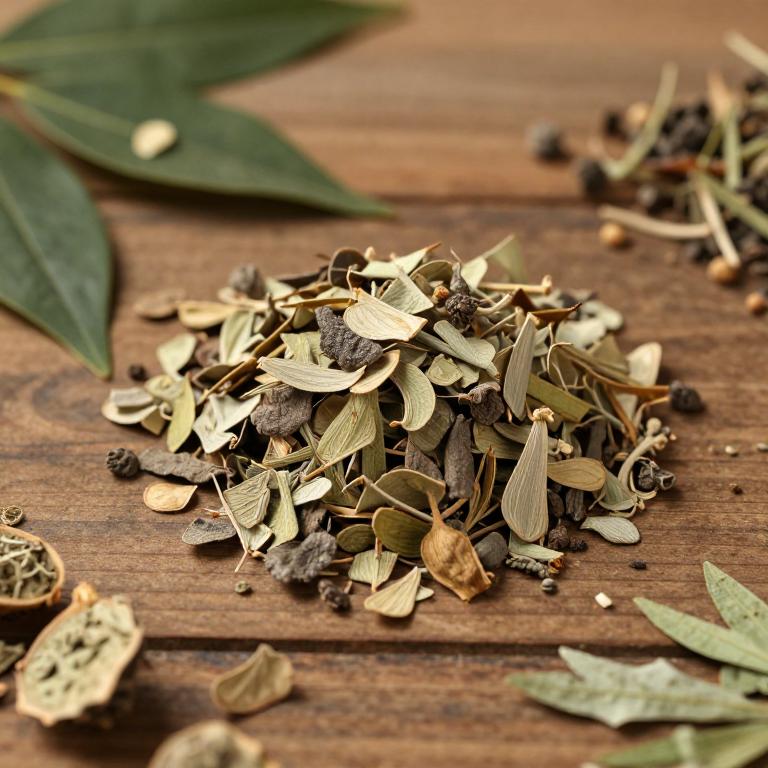Camphor Tree (Cinnamomum Camphora)
Information Reliability Score: 5/10
This score reflects the overall reliability of the information presented in this article. It is based on the quality of scientific evidence, accuracy of sources, and the transparency of references related to Cinnamomum camphora.

Camphor Tree, scientifically known as Cinnamomum camphora, is a flowering plant native to East Asia, widely recognized for its medicinal properties and versatile applications.
This evergreen tree is not only a source of camphor, a compound with a distinctive, sharp aroma, but also a valued medicinal herb and adaptogen used in traditional and modern wellness practices. Its primary benefits include anti-inflammatory, analgesic, and antimicrobial properties, making it useful for treating respiratory issues, muscle pain, and skin conditions. In traditional Chinese medicine, the camphor tree has been used for centuries to treat ailments such as colds, coughs, and fever, while its leaves and bark are also employed in aromatherapy and as a spice in culinary applications.
The tree's unique combination of historical significance, cultural reverence, and therapeutic potential continues to make it a significant player in both traditional and contemporary holistic health practices.
FREE CHECKLIST
The Only 10 Herbs You Need to Heal 90% of Common Ailments.

Table of Contents
Scientific and Botanical Profile
Camphor Tree, with botanical name Cinnamomum camphora, is a member of the Lauraceae family and is native to China, Japan, Korea, Taiwan, Southeast Asia, Indonesia, the Philippines, and India.
It is commonly known by various names including Chinese Camphor Tree, Camphor Laurel, Cinnamomum Camphora, Chinese Camphor, Camphorwood, and Cinnamon Tree. The tree is a large evergreen with a straight trunk, dense foliage, and dark green, glossy leaves that are elliptical in shape and have a distinctive aromatic scent. It produces small yellow flowers followed by dark blue-black berries, and is valued for its aromatic wood and medicinal properties.
This versatile tree is widely cultivated for its camphor-rich timber and has a long history of use in traditional medicine and as a source of essential oils.
History and Cultural Relevance
Camphor Tree was used for centuries in various cultures for its medicinal, aromatic, and spiritual properties, with its essential oils and wood being highly valued in traditional medicine systems such as Chinese and Ayurvedic practices.
In ancient China, the tree was revered not only for its camphor resin, which was used to treat ailments like colds and headaches, but also for its spiritual significance, often planted near temples and homes to ward off evil spirits. The tree holds deep cultural importance in East Asian traditions, where it is featured in rituals, festivals, and even in the making of incense and traditional remedies. Today, camphor oil is still used in topical treatments for muscle pain and respiratory issues, and its essential oil remains a key ingredient in many over-the-counter pain relievers and aromatherapy products.
Its enduring presence in both historical and contemporary contexts highlights its lasting cultural and medicinal relevance across the world.
Chemical Composition and Nutritional Profile
Camphor Tree contains a variety of bioactive compounds, including camphor, cineole, and limonene, which are primarily derived from its essential oils and contribute to its medicinal properties.
The plant also contains alkaloids, flavonoids, and terpenes that exhibit anti-inflammatory, antimicrobial, and antioxidant activities. Nutritional-wise, the Camphor Tree is not a significant source of macronutrients but is rich in certain micronutrients such as vitamin C, vitamin E, and minerals like potassium and magnesium. These compounds work synergistically to support immune function, reduce oxidative stress, and modulate cellular responses.
The mechanism of action involves the interaction of these compounds with biological targets such as cell membranes, enzymes, and receptors, leading to therapeutic effects in various health conditions.
Medicinal Properties and Health Benefits
Cinnamomum camphora has been traditionally used in herbal medicine for its wide range of medicinal properties, including anti-inflammatory, antimicrobial, and analgesic effects.
It supports multiple body systems, such as the respiratory, digestive, and nervous systems, by helping to alleviate symptoms like coughing, indigestion, and stress-related anxiety. Compared to similar herbs like eucalyptus or lavender, cinnamomum camphora offers a more potent combination of cooling and warming effects, making it particularly effective for conditions involving both inflammation and stagnation. Its essential oil is often used in aromatherapy to promote relaxation and improve mental clarity, which sets it apart from other herbs with more singular therapeutic applications.
Overall, its versatility and balanced action make it a valuable herb in both traditional and modern holistic medicine.
Discover the 10 best health benefits of Camphor Tree.
Forms, Preparation and Usage
Cinnamomum camphora has a variety of forms available, including fresh leaves, dried tincture, powder, essential oil, and capsule, each offering different methods of preparation and application.
It can be prepared as a tea by steeping dried leaves in hot water, or as a decoction by boiling the leaves for a longer period to extract more active compounds. Topical applications include using the essential oil diluted in a carrier oil for massage or applying a powder directly to the skin for localized relief. The recommended dosage for adults is typically 1-2 teaspoons of the dried herb per cup of water, while children should only use it under medical supervision if deemed safe.
Due to its potent nature, it is advised to use cinnamomum camphora sparingly, with a frequency of no more than 2-3 times per week and a duration of use limited to a few weeks to avoid potential side effects.
Safety, Side Effects and Contraindications
Cinnamomum camphora can be used cautiously for its medicinal properties, but it is important to be aware of its potential risks.
While it may offer benefits such as anti-inflammatory and antispasmodic effects, it can also cause side effects like gastrointestinal upset, skin irritation, and in some cases, more severe reactions such as respiratory distress or allergic responses. It may interact with certain medications, including anticoagulants and central nervous system depressants, potentially increasing their effects or causing adverse reactions. Special populations, such as pregnant or breastfeeding women, should avoid its use due to limited safety data and potential risks to the fetus or infant, while individuals with chronic illnesses should consult a healthcare provider before use.
To ensure safety, it is recommended to use cinnamomum camphora only under medical supervision, follow recommended dosages, and discontinue use if any adverse effects occur.
Growing, Harvesting and Storage
Cinnamomum camphora grows best in well-drained, loamy soil that is rich in organic matter and slightly acidic to neutral in pH, with full sun to partial shade for optimal growth.
It requires regular watering, especially during dry periods, but should not be overwatered to avoid root rot. Regular pruning and fertilization with a balanced fertilizer during the growing season help maintain its health and promote the development of aromatic leaves and bark. Harvesting is best done in the fall when the essential oils are most concentrated, using a combination of hand-cutting and careful stripping of the bark to preserve the plant's vitality.
For storage, the harvested material should be dried in a cool, shaded area, then stored in airtight containers away from moisture and light to preserve its potency and medicinal properties.